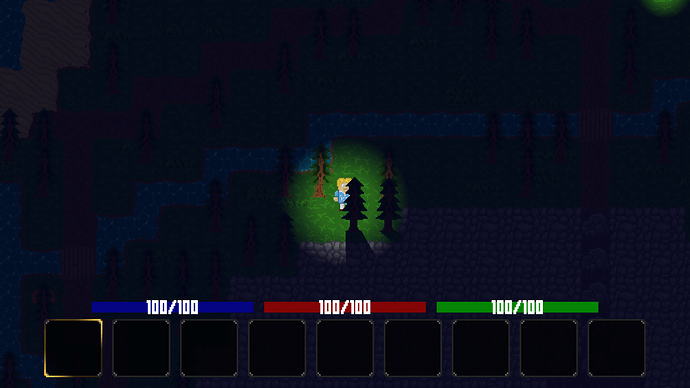Hello there! I have been working on a top-down 2D style game, and am now working on the lighting for the day/night cycle. I have decided to use a form of ray-marching to create the lighting. Basically, every entity in the game has a “wall” that is used to create shadows, and a “building” to represent the texture of the entity, so make sure that the actual texture itself is also shaded. Here is an example of what it currently looks like:
The issue is that it seems that more entities makes the shader run very slowly (slower than it probably should). Can anyone tell me if I am doing anything horribly wrong/inefficient within my shader?
Here is the shader code (sorry if its a bit messy)
#version 440 core
#ifdef GL_ES
precision mediump float;
#endif
layout(origin_upper_left) in vec4 gl_FragCoord;
uniform vec4[128] lights; // First 2 are xy of the light pt, second is the light radius, 3rd is the distance until disipate
uniform int lightSize;
uniform vec4[128] walls; // First 2 are the xy of pt1, second 2 are the xy of pt2
uniform int wallSize;
uniform float darknessPercent;
uniform float sizeMultiplier;
uniform sampler2D[128] buildings; // Textures of buildings, for info on darkening them
uniform vec2[128] buildingPositions; // Position offset of buildings
uniform int numBuildings;
float approx_distance(float dx, float dy);
void main() {
gl_FragCoord * vec4(1.0,-1.0,1.0,1.0);
bool insideBuilding = false;
float maxBuildingY = 0;
for (int i = 0; i < numBuildings; i++) {
vec2 curPos = gl_FragCoord.xy;
vec2 bldgSize = vec2(textureSize(buildings[i], 0));
curPos.x -= buildingPositions[i].x;
curPos.y -= buildingPositions[i].y;
curPos.x /= 3 * sizeMultiplier;
curPos.y /= 3 * sizeMultiplier;
if (!(curPos.x < 0 || curPos.x >= bldgSize.x || curPos.y < 0 || curPos.y >= bldgSize.y)) {
vec4 color = texture(buildings[i], curPos.xy / bldgSize.xy);
if (color.a > 0){
insideBuilding = true;
float newMaxBuildingY = buildingPositions[i].y + bldgSize.y * 3 * sizeMultiplier;
if (maxBuildingY < newMaxBuildingY) maxBuildingY = newMaxBuildingY;
}
}
}
float maxBrightness = 0;
for (int i = 0; i < lightSize; i++) {
vec4 cur = lights[i];
// Check that the point doesnt cross a line
bool crosses = false;
float maxCrossY = 0;
for (int j = 0; j < wallSize; j++) {
vec4 lnAB = walls[j];
vec4 lnCD = vec4(cur.x,cur.y,gl_FragCoord.x,gl_FragCoord.y);
if ((abs(lnAB.x - gl_FragCoord.x) + abs(lnAB.y - gl_FragCoord.y)) > 10000) {
continue;
}
float maxY = lnAB.y;
if(maxY < lnAB.w) maxY = lnAB.w;
if(maxY < lnCD.y)
continue;
if (lnAB.z == lnAB.x){
lnAB.z -= 1;
}
if (lnCD.z == lnCD.x){
lnCD.z -= 1;
}
float m1 = (lnAB.w - lnAB.y) / (lnAB.z - lnAB.x);
float m2 = (lnCD.w - lnCD.y) / (lnCD.z - lnCD.x);
if (m1 != m2){
float xCross = (-m2 * lnCD.x + lnCD.y + m1*lnAB.x - lnAB.y) / (m1 - m2);
if (
((xCross >= lnAB.x && xCross <= lnAB.z) || (xCross >= lnAB.z && xCross <= lnAB.x)) &&
((xCross >= lnCD.x && xCross <= lnCD.z) || (xCross >= lnCD.z && xCross <= lnCD.x))
) {
// Lines cross
crosses = true;
maxCrossY = maxY;
break;
}
}
}
float brightnessMultiplier = 1;
if (insideBuilding) {
if (cur.y < maxBuildingY) {
brightnessMultiplier = 1 - abs(maxBuildingY - cur.y) / (60 * sizeMultiplier);
}
} else if (crosses) {
brightnessMultiplier = 1 - abs(maxCrossY - cur.y) / (60 * sizeMultiplier);
}
if (brightnessMultiplier < 0) brightnessMultiplier = 0;
float distanceDelta = distance(gl_FragCoord.xy, cur.xy) - cur.w * sizeMultiplier;
if (distanceDelta < 0)
distanceDelta = 0;
float brightnessDelta = ((cur.z)*sizeMultiplier - distanceDelta)/((cur.z) * sizeMultiplier);
if (brightnessDelta > 0) {
maxBrightness += brightnessDelta * brightnessMultiplier;
}
}
gl_FragColor = vec4(0.0, 0.0, 25.0 / 255.0, (225.0 / 255.0) * darknessPercent - (225.0 / 255.0) * darknessPercent * maxBrightness);
}
Thanks!
